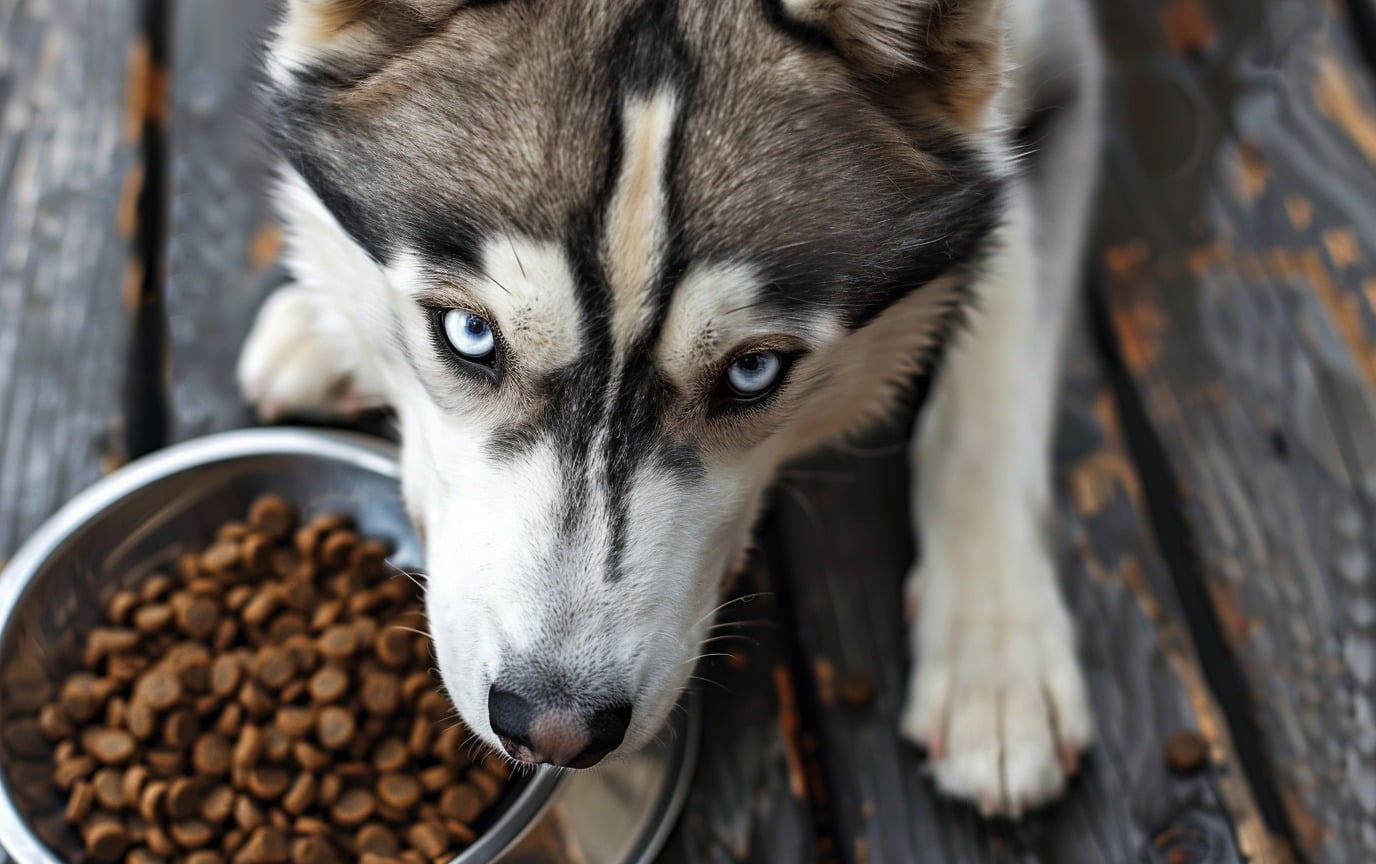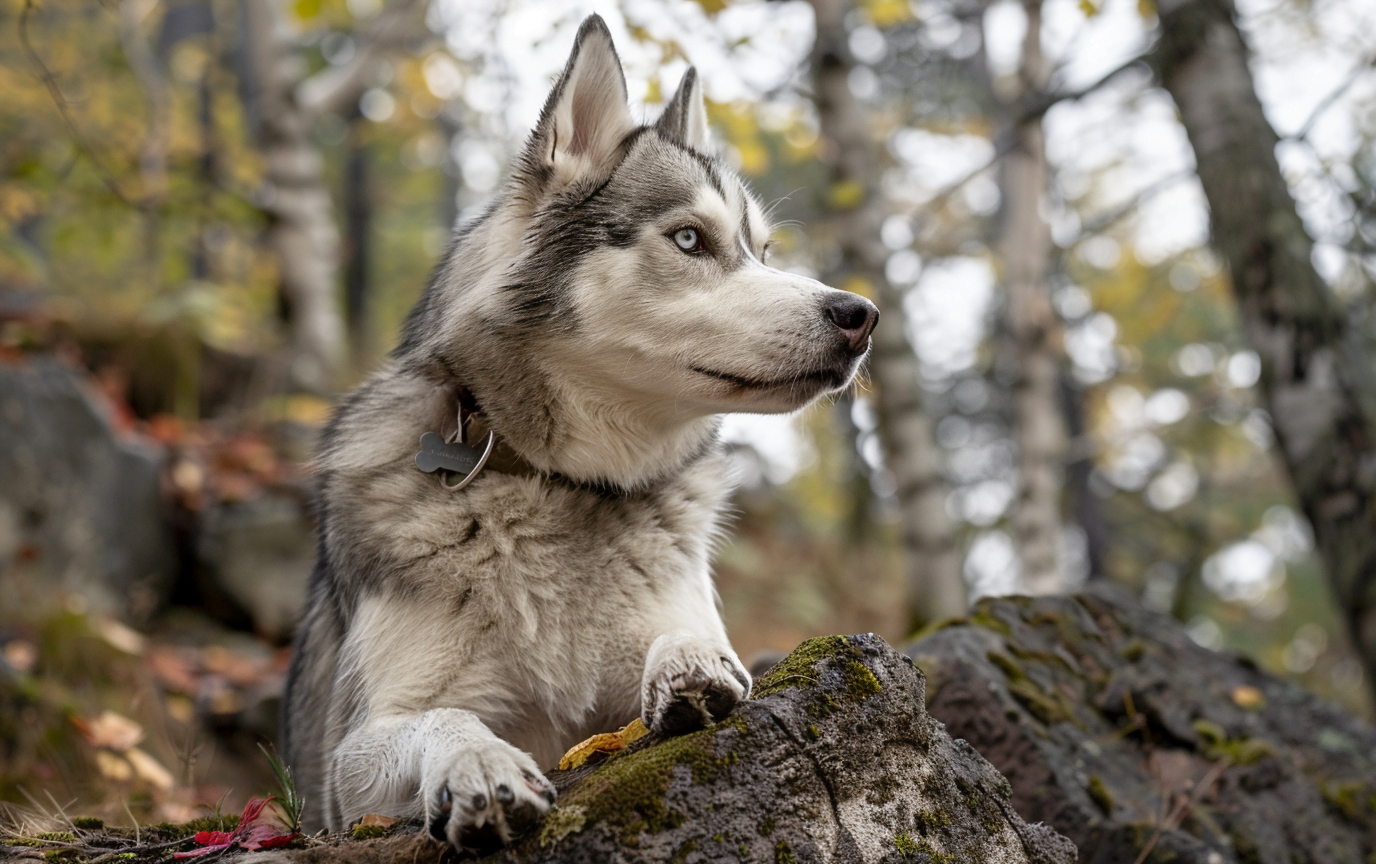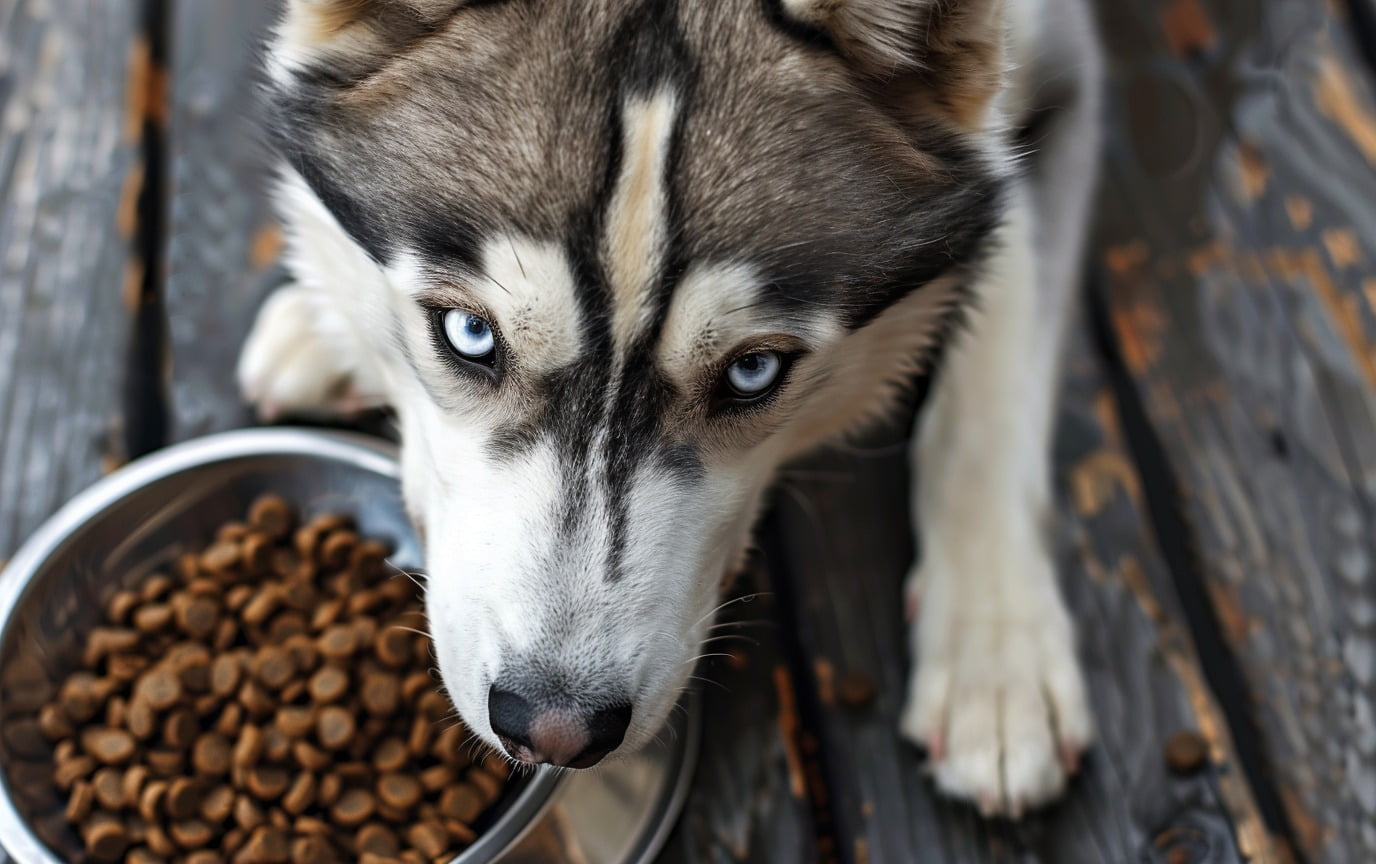Siberian Huskies – those captivating canines with eyes as blue as ice and a spirit as boundless as the tundra they hail from. They’re renowned for their striking looks, playful personalities, and seemingly endless energy. But beneath that fluffy coat and mischievous grin lies a unique physiology that demands a special diet. Just like their wolf ancestors, Huskies have specific nutritional needs that must be met to keep them in tip-top shape.
Now, you might be thinking, “Dog food is dog food, right?” Wrong! Feeding your Husky the same kibble you’d give a Chihuahua is like fueling a race car with diesel – it just won’t work. Huskies require a diet that can sustain their active lifestyle, nourish their thick double coat, and prevent potential health issues down the line.
But don’t worry, fellow Husky enthusiasts! We’re here to guide you through the sometimes-confusing world of dog food. In this article, we’ll break down everything you need to know to choose the perfect chow for your furry friend, from understanding their nutritional needs to deciphering ingredient lists like a pro. By the end, you’ll be armed with the knowledge to make informed decisions about your Husky’s diet, ensuring they stay happy, healthy, and full of pep.

Fueling the Husky Engine: A Deep Dive into Their Nutritional Needs
Alright, let’s get down to the nitty-gritty: what exactly does a Husky need to thrive? These aren’t your average couch potato pooches, folks. Huskies are built for endurance, with a metabolism that rivals a marathon runner’s. Their dietary needs reflect this high-energy lifestyle.
Protein Power
Think of protein as the building blocks for those impressive Husky muscles. It’s essential for maintaining lean body mass, repairing tissues, and supporting a healthy immune system.
- The Gold Standard: Look for dog foods that list real meat as the first ingredient. Chicken, fish, lamb, and beef are all excellent sources of protein that Huskies will gobble up.
- Plant vs. Animal: While some plant-based proteins can contribute to a Husky’s diet, they shouldn’t be the primary source. Animal proteins are more easily digested and contain a complete amino acid profile, which is crucial for overall health.
Fat for Fur and Function
Don’t shy away from fat! Huskies need a good amount of healthy fats to keep their coats shiny, their skin supple, and their joints lubricated.
- Omega-3 and Omega-6: These fatty acids are particularly important for Huskies. They help reduce inflammation, support cognitive function, and even contribute to a happy mood. You’ll find them in fish oil, flaxseed, and certain types of meat.
- Not All Fats are Created Equal: Avoid dog foods that contain excessive amounts of saturated or trans fats. These unhealthy fats can lead to weight gain, heart problems, and other health issues.
Carbs: Energy in Moderation
Carbohydrates provide Huskies with the energy they need to zoom around the dog park and pull sleds through the snow. But too many carbs can lead to unwanted weight gain, which can put a strain on their joints.
- Complex Carbs: Opt for dog foods that contain complex carbohydrates like sweet potatoes, brown rice, and oats. These release energy slowly, keeping your Husky feeling full and energized throughout the day.
- Simple Carbs: Limit simple carbohydrates like corn, wheat, and white rice. These are quickly digested and can cause spikes in blood sugar levels, which can lead to energy crashes and cravings.
Demystifying Dog Food: Kibble, Canned, Raw, Oh My!
Alright, now that we’ve got a handle on what Huskies need to eat, let’s talk about the different types of dog food available. Walking down the pet food aisle can feel like navigating a maze – so many brands, flavors, and formulas! But fear not, we’ll break it down for you.
Kibble: The Classic Crunch
Kibble is the most common type of dog food, and for good reason. It’s convenient, affordable, and comes in a seemingly endless variety of flavors. But is it the best choice for your Husky?
- Pros: Kibble is easy to store and transport, making it a great option for on-the-go Huskies and their humans. It’s also relatively inexpensive compared to other types of dog food. The crunchy texture can help keep your Husky’s teeth clean and reduce tartar buildup.
- Cons: Kibble is often highly processed and may contain low-quality ingredients, such as meat by-products and fillers like corn and wheat. Some kibble brands are also high in carbohydrates, which can lead to weight gain in Huskies.
A Word on Grain-Free:
Grain-free diets have become increasingly popular in recent years, but are they necessary for Huskies? The answer isn’t always a clear-cut “yes” or “no.”
- The Grain-Free Debate: While some Huskies may have sensitivities to certain grains, others thrive on a diet that includes whole grains. It’s important to talk to your veterinarian about whether a grain-free diet is right for your Husky.
- Proceed with Caution: Some grain-free diets have been linked to a heart condition called dilated cardiomyopathy (DCM) in certain breeds. While more research is needed, it’s important to be aware of this potential risk and discuss it with your vet.

Canned Food: Wet and Wonderful
Canned dog food offers a different experience for your Husky’s taste buds. It’s often more palatable than kibble and can be a good option for picky eaters or Huskies with dental problems.
- Pros: Canned food typically contains more moisture than kibble, which can help keep your Husky hydrated. It also tends to be more flavorful and can be a good way to add variety to your Husky’s diet.
- Cons: Canned food can be more expensive than kibble and may not be as convenient to store and transport. It’s also important to check the ingredient list carefully, as some canned foods contain high amounts of sodium and other undesirable ingredients.
Raw Food: A Walk on the Wild Side
Raw food diets are becoming increasingly popular among dog owners who want to mimic their pets’ ancestral diet. But is raw food right for your Husky?
- Pros: Proponents of raw food diets claim that they provide a more natural and nutritious diet for dogs. Raw food is typically made with high-quality ingredients, such as muscle meat, organ meat, bones, and vegetables.
- Cons: Raw food diets can be expensive and time-consuming to prepare. There is also a risk of bacterial contamination if the food is not handled properly. It’s important to talk to your veterinarian before starting your Husky on a raw food diet.
Picking the Perfect Kibble: A Guide to Choosing the Best Dog Food for Your Husky
Now comes the fun part: choosing the actual food that will fill your Husky’s bowl! With so many options on the market, it can feel overwhelming. But armed with our knowledge of Husky nutrition and dog food types, we can narrow down the choices and find the perfect fit for your furry friend.
Key Considerations:
Age Matters: A Husky puppy needs different nutrients than an adult or senior dog. Puppy food is typically higher in calories and protein to support their rapid growth, while senior formulas are designed to be easier on aging joints and digestive systems. Make sure to choose a food that’s appropriate for your Husky’s life stage.
Energy Level: How active is your Husky? If they’re a sled-pulling champion or an avid hiker, they’ll need a higher-calorie food than a more laid-back pup. Look for foods that are specifically formulated for active or working dogs.
Health Concerns: Does your Husky have any allergies or sensitivities? Certain ingredients, like corn, wheat, and soy, are common culprits for triggering allergic reactions in dogs. If your Husky has any health issues, talk to your veterinarian about choosing a food that addresses their specific needs.
Ingredient Quality: This is where things get interesting. Always read the ingredient list carefully and look for the following:
- Real Meat First: The first ingredient should be a named source of animal protein, like chicken, lamb, or fish. Avoid foods that list meat by-products or generic terms like “meat meal.”
- Whole Grains and Vegetables: If the food contains grains, opt for whole grains like brown rice or oatmeal. Look for vegetables like sweet potatoes, carrots, and peas, which provide essential vitamins and minerals.
- Healthy Fats: Fish oil is a great source of omega-3 fatty acids, which are crucial for a Husky’s skin and coat. Other healthy fats include flaxseed oil and chicken fat.
- Limited Ingredients: Choose foods with a shorter ingredient list, as this often indicates a higher quality product with fewer fillers and artificial ingredients.
Brand Reputation: Do your research on different dog food brands and choose one that has a good reputation for producing high-quality, nutritious food. Check online reviews and talk to other Husky owners for recommendations.
Top Dog Food Picks for Your Husky: Expert Recommendations and Honest Reviews
Get those taste buds ready! We’re about to dig into some of the top-rated dog foods that have won over the hearts (and stomachs) of Huskies and their discerning owners alike. We’ve scoured expert opinions, user reviews, and ingredient lists to bring you a selection of kibble brands that cater to your Husky’s unique needs.
Taste of the Wild: High Prairie Canine Formula
If your Husky has a taste for adventure, they’ll likely drool over Taste of the Wild’s High Prairie Canine Formula. This grain-free kibble is packed with protein from real buffalo and bison, along with roasted venison and smoked salmon for a flavor that’s as wild as your pup.
- Pros: High protein content, grain-free formula, diverse protein sources, includes probiotics for digestive health.
- Cons: Some Huskies may find the protein levels too high, can be pricey.
Orijen: Original Grain-Free Dry Dog Food
Orijen is known for its commitment to using fresh, regionally sourced ingredients. Their Original Grain-Free formula features a whopping 85% animal ingredients, including free-run chicken, wild-caught fish, and cage-free eggs.
- Pros: Exceptionally high meat content, grain-free formula, includes nutrient-rich organ meats.
- Cons: Can be very expensive, may not be suitable for all Huskies due to high protein content.
Acana: Heritage Regionals Grasslands Dry Dog Food
Acana’s Heritage Regionals Grasslands formula takes inspiration from the diets of wild canines, featuring a blend of free-run poultry, cage-free eggs, and wild-caught fish. It’s also grain-free and packed with fruits and vegetables for added nutrients.
- Pros: High meat content, grain-free formula, includes a variety of animal sources, contains probiotics.
- Cons: Some Huskies may not tolerate the high protein levels, can be on the pricier side.
Blue Buffalo Wilderness: High Protein Grain-Free, Natural Adult Dry Dog Food
Blue Buffalo Wilderness’ High Protein formula is a favorite among active Huskies. It features real chicken as the first ingredient, along with a blend of fruits and vegetables for a balanced diet. It’s also grain-free and contains LifeSource Bits, a blend of antioxidants, vitamins, and minerals.
- Pros: High protein content, grain-free formula, includes LifeSource Bits for added nutrition.
- Cons: Some Huskies may not tolerate the grain-free formula, contains peas and potatoes, which have been linked to potential heart issues in some dogs.
Wellness Core: Grain-Free Original Recipe Dry Dog Food
Wellness Core’s Grain-Free Original Recipe is a high-protein, low-carb option that many Husky owners swear by. It features deboned turkey, chicken meal, and salmon meal as the main protein sources, along with fruits and vegetables for added nutrition.
- Pros: High protein content, grain-free formula, includes probiotics for digestive health.
- Cons: Some Huskies may not tolerate the grain-free formula, can be pricey.
Fromm Family Foods: Four-Star Nutritionals Salmon A La Veg Dry Dog Food
If you’re looking for a grain-inclusive option, Fromm Family Foods’ Salmon A La Veg is a great choice. It features salmon as the first ingredient, along with brown rice, oatmeal, and a variety of vegetables.
- Pros: High-quality protein source, includes whole grains and vegetables, suitable for Huskies with grain sensitivities.
- Cons: Some Huskies may prefer a grain-free formula, may not be as high in protein as other options.
Special Delivery: Tailored Grub for Pups, Adults, and Seniors
Huskies, like all dogs, go through different life stages, each with unique nutritional needs. A puppy’s diet should be drastically different from a senior’s, and even adult Huskies can benefit from specific formulas based on their activity levels. Let’s break down the ideal eats for every stage of your Husky’s life.
Puppy Power: Fueling Growth and Development
Those adorable Husky pups are bundles of energy, constantly exploring, playing, and growing at an astonishing rate. Their diet needs to keep up with their rapid development.
- Higher Calories and Protein: Puppy food should be higher in calories and protein than adult food to support muscle growth and development. Look for a formula that contains at least 22% protein and 8% fat.
- DHA for Brainpower: Docosahexaenoic acid (DHA), an omega-3 fatty acid found in fish oil, is crucial for brain and eye development in puppies. Choose a puppy food that includes DHA or consider adding a fish oil supplement.
- Calcium for Strong Bones: Puppies need plenty of calcium to build strong bones and teeth. Look for a food that is specifically formulated for large breed puppies, as their bones grow at a slower rate than small breed puppies.
Adult Adventures: Maintaining Peak Performance
Once your Husky reaches adulthood (around 1 year old), they’ll need a food that supports their active lifestyle and helps them maintain a healthy weight.
- Balanced Nutrition: Adult Huskies need a diet that’s balanced in protein, fat, and carbohydrates. Look for a formula that contains around 18-25% protein and 5-15% fat.
- Joint Support: Active Huskies can benefit from a food that includes glucosamine and chondroitin, which support joint health and can help prevent arthritis later in life.
- Skin and Coat Health: Look for a food that contains omega-3 and omega-6 fatty acids to keep your Husky’s coat shiny and their skin healthy.
Senior Serenity: Gentle Nutrition for Golden Years
As Huskies age, their metabolism slows down, and their activity levels may decrease. Their dietary needs also change, requiring a food that’s easier on their aging bodies.
- Lower Calories: Senior dog food should be lower in calories than adult food to prevent weight gain. However, it should still contain high-quality protein to maintain muscle mass.
- Joint Support: Glucosamine and chondroitin are even more important for senior Huskies, as they can help manage arthritis and other joint issues.
- Digestive Health: Look for a food that’s easy to digest and contains fiber to promote healthy bowel movements.
Chow Time! Practical Tips for Feeding Your Husky
So, you’ve chosen the perfect kibble (or maybe even dabbled in raw or wet food). Now, how do you actually feed your Husky? Don’t worry, it’s not rocket science, but there are a few things to keep in mind to ensure your furry friend gets the most out of their meals.
Portion Control: Don’t Overdo It!
Huskies are notorious for their love of food, and their pleading eyes can make it tempting to overfeed them. But remember, a well-fed Husky is a healthy Husky, and overfeeding can lead to obesity and other health problems.
- Follow the Guidelines: Most dog food bags have feeding guidelines based on your dog’s weight and activity level. Start with these recommendations and adjust as needed based on your Husky’s individual needs.
- Measure, Don’t Guess: Use a measuring cup to ensure you’re giving your Husky the correct amount of food. Don’t just eyeball it – those puppy dog eyes can be deceiving!
- Body Condition Score: Regularly assess your Husky’s body condition. You should be able to feel their ribs easily, but they shouldn’t be visible. If you can’t feel their ribs or their waistline has disappeared, it may be time to cut back on the food.
Feeding Frequency: How Often Should You Feed?
The number of times you feed your Husky per day will depend on their age and activity level.
- Puppies: Young Huskies need to eat more frequently than adults to support their growth. Aim for three to four meals per day until they are about six months old, then gradually reduce it to two meals per day.
- Adults: Most adult Huskies do well on two meals per day. However, some highly active dogs may benefit from three smaller meals.
- Seniors: Senior Huskies may need to eat less often, as their metabolism slows down. Talk to your vet to determine the best feeding schedule for your older dog.
Picky Eaters: Dealing with Discerning Huskies
Some Huskies are pickier than others when it comes to food. If your Husky turns up their nose at their kibble, don’t despair – there are a few tricks you can try.
- Warm it Up: Adding a little warm water or broth to dry kibble can make it more appealing to some dogs.
- Mix it Up: Try mixing in a small amount of wet food or cooked meat to add flavor and variety.
- Top it Off: Sprinkle some grated cheese, chopped vegetables, or a few pieces of cooked chicken on top of their kibble to make it more interesting.
- Food Puzzles: Interactive food toys can make mealtime more fun and engaging for your Husky. It also encourages them to eat slower, which can help with digestion.
Transitions: Introducing New Foods Gradually
If you’re switching your Husky to a new food, it’s important to do so gradually to avoid upsetting their stomach.
- Mix it In: Start by mixing a small amount of the new food with their old food. Gradually increase the ratio of new food to old food over a period of 7-10 days.
- Monitor for Digestive Issues: Watch for any signs of digestive upset, such as vomiting, diarrhea, or loss of appetite. If your Husky experiences any of these symptoms, slow down the transition or talk to your vet.
The Golden Rule: Fresh Water Always!
Always make sure your Husky has access to fresh, clean water. This is especially important for active dogs and those who eat a dry food diet.
Dealing with Dietary Dilemmas: Picky Eaters, Allergies, and More
Let’s face it – Huskies can be a bit particular about their food. Some are champion gobblers, while others turn their noses up at anything that doesn’t meet their discerning palates. And then there are the allergies, sensitivities, and other dietary quirks that can make mealtime a bit of a challenge. But fear not, fellow Husky lovers! We’ve got some tips and tricks to help you navigate these common feeding hurdles.
The Picky Eater: Turning Mealtime into a Feast
Does your Husky stare at their food bowl with a look of disdain? Do they sniff it, take a few lackluster bites, and then walk away? Picky eating can be frustrating, but it’s not uncommon in Huskies. Here are a few strategies to entice your finicky furball:
- Mix it Up: Monotony is the enemy of appetite. Try adding a little variety to your Husky’s meals. Mix kibble with a spoonful of wet food, sprinkle some cooked meat or veggies on top, or even offer a different flavor of kibble each day.
- Warm it Up: Some Huskies prefer their food slightly warmed. Try adding a little warm water or broth to their kibble to release the aromas and make it more appealing.
- Slow and Steady: If your Husky is used to gobbling down their food, try feeding them smaller portions more frequently throughout the day. This can help prevent them from getting overwhelmed and encourage them to eat more.
- Food Puzzles: Interactive feeders and food puzzles can make mealtime more fun and engaging for your Husky. They also encourage slower eating, which can aid digestion.
Allergies and Sensitivities: The Itchy and Scratchy Truth
Huskies, like any other breed, can be prone to food allergies and sensitivities. Common culprits include chicken, beef, dairy, eggs, and grains. If you notice your Husky experiencing symptoms like itchy skin, ear infections, or digestive problems, it could be a sign of a food allergy.
- Elimination Diet: The most reliable way to diagnose a food allergy is through an elimination diet. This involves feeding your Husky a novel protein and carbohydrate source that they haven’t eaten before for several weeks to see if their symptoms improve.
- Limited Ingredient Diets: If your Husky has a confirmed food allergy, your vet may recommend a limited ingredient diet (LID). These diets contain a single protein source and a limited number of other ingredients, making it easier to identify and avoid triggers.
- Hydrolyzed Protein Diets: In severe cases, a hydrolyzed protein diet may be necessary. These diets contain protein that has been broken down into smaller particles, making it less likely to trigger an allergic reaction.
Other Dietary Quirks: From Zinc Deficiency to Sensitive Stomachs
Huskies are prone to a few other dietary quirks that are worth mentioning:
- Zinc Deficiency: Huskies are predisposed to a condition called zinc-responsive dermatosis, which can cause skin problems and hair loss. If your Husky is experiencing these symptoms, your vet may recommend a zinc supplement or a food that’s specifically formulated for Huskies with this condition.
- Sensitive Stomachs: Some Huskies have sensitive stomachs and may experience vomiting or diarrhea if their diet is changed too quickly. If you’re switching your Husky’s food, do so gradually over a period of 7-10 days.
- Weight Management: Huskies can be prone to obesity if they’re overfed or not getting enough exercise. If your Husky is overweight, talk to your vet about switching to a weight management formula or reducing their portion sizes.
You might be wondering, “Can I share my Greek yogurt with my Husky?” That’s a great question! Let’s dive into the creamy details.
Conclusion
There you have it, a comprehensive guide to finding the best dog food for your beloved Husky. Remember, your furry friend is a unique individual, and their dietary needs may differ slightly from the general recommendations we’ve covered. Always consult with your veterinarian for personalized advice on feeding your Husky.
FAQs
What specific ingredients should I look for in dog food for my active Husky to ensure sustained energy levels throughout the day?
For your energetic Husky, prioritize dog food that boasts high-quality protein sources as its main ingredients. Think along the lines of real meat like chicken, lamb, or fish – not just meat by-products. These provide essential amino acids for muscle repair and growth, crucial for those long runs and playful romps.
Additionally, look for healthy fats like those found in fish oil or chicken fat. These not only support a shiny coat but also provide a concentrated energy source, perfect for fueling your Husky’s adventures.
Complex carbohydrates like sweet potatoes, brown rice, or oatmeal offer sustained energy release, preventing those dreaded mid-day crashes.
My Husky has a sensitive stomach. Are there particular dog food brands known for being gentle on digestion while still meeting a Husky’s nutritional needs?
Absolutely! Some brands understand the tummy troubles that some Huskies face. Consider options like:
- Royal Canin Gastrointestinal: This formula is specially designed for dogs with digestive sensitivities, using highly digestible ingredients and prebiotics to support gut health.
- Hill’s Science Diet Sensitive Stomach & Skin: This food features easily digestible proteins and prebiotic fiber to soothe sensitive stomachs and nourish a healthy skin barrier.
- Purina Pro Plan Sensitive Skin & Stomach: Formulated with salmon and rice, this option offers gentle nutrition for dogs prone to digestive upset.
- Nutro Limited Ingredient Diet: These formulas are made with a single protein source and limited ingredients, reducing the risk of triggering sensitivities.
Remember, every Husky is different, so it might take a bit of trial and error to find the perfect fit for your furry friend’s tummy.

Healthy dogs mean happy dogs, and that makes me happy! I’m here to share all the tips for keeping your best furry friend in top shape, from puppyhood to their golden years.

